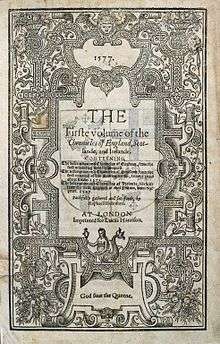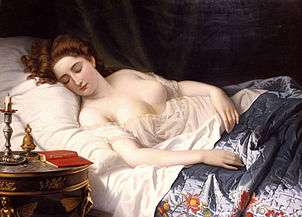Raphael Holinshed
Raphael Holinshed (c. 1525–1580?) whose first name is spelled with a double "l" on various title pages, ie "Raphaell," was an English chronicler, who was most famous for his work on The Chronicles of England, Scotlande, and Irelande, commonly known as Holinshed's Chronicles. It was the "first complete printed history of England composed as a continuous narrative". [1] The Holinshed Chronicles was a major influence on many Renaissances writers, such as William Shakespeare, Spenser, Daniel, and Marlowe. [2] While not well-known, The Holinshed Chronicles set a precedent for a new age of play-writing. Even though they were underappreciated, the Holinshed Chronicles are still respected by those who know their far-reaching effects.

Biography
Little is known about Holinshed's life and for the most part his early years are primarily a matter of speculation. Holinshed was most likely born to Ralph Holinshed of Cophurst in Sutton Downes, Cheshire. The date of his birth is unknown.[3] Holinshed is assumed to have received an education from student records from Christ's College in Cambridge, which show a student under the name Holinshed attending the school from 1544 to 1545. [4] In his later years, he lived in London where he worked as a translator for the printer, Reyner Wolfe. Wolfe gave him the project of compiling a world history from the Flood to the reign of Queen Elizabeth. Holinshed was only one contributor to this work; others involved in its production included George Bishop, John Hunne, and Lucus Harrison. [1]
Vernon Snow, an author who writes an introduction to Holinshed's Chronicles in the later edition, remarks that Holinshed was an experienced Cambridge-educated translator. As far as anyone knows, no other known works by Holinshed are available. A few months after the Chronicles had been licensed, Holinshed retired to the countryside near Warwick where he died around 1580. His will was proven on 24 April 1582, leaving his belongings and estate to a Mr. Burdet, whom he referred to as his master. [5] Holinshed's Chronicles was published soon after his death.
Holinshed's Chronicles of England, Scotland and Ireland
The idea for Holinshed Chronicles was born from Reginald (or Reyner) Wolfe. A London printer, Wolfe was one of the original members of the Royal Stationers' Company. In 1548 Reyner Wolfe conceived the idea of creating a "Universal Cosmography of the whole world, and there with also certain particular histories of every known nation". He wanted the work to be printed in English and he wanted maps and illustrations in the book as well. Wolfe acquired many of John Leland's works and with these he constructed chronologies and drew maps that were up to date. This took over 24 years of his life; however, when Wolfe realized he could not complete this project on his own, he hired Raphael Holinshed and William Harrison to assist him. [1]
Wolfe died with the work still uncompleted in 1573, and the project, changed to a work about just the British Isles (England, Ireland, and Scotland), was run by a consortium of three members of the London stationers. They kept Raphael Holinshed, who employed William Harrison, Richard Stanyhurst, Edmund Campion and John Hooker. In 1577, the work was published in two volumes after some censorship by the Privy Council of some of Stanyhurst's contribution on Ireland.[3]
A second edition was issued in 1587 (also included many woodcut illustrations to go along with the chronicles), but it contained some passages that were considered offensive to the Queen and her ministers. The pages in question were removed by order of the Privy Council. The missing passages were separately published in 1723, and a complete reprint appeared in 1807.[3] Holinshed's Chronicles was an "extremely popular work when it was first published," but "by the seventeenth century it was already considered outdated and inaccurate", losing its popularity and credibility. [1]
Although it is very underappreciated, the play, or collection of, provides us with an abundance of opinions regarding the late Tudor culture. Holinshed's Chronicles did not receive the credit that it deserved due to the fact that it merely lacked certain characteristics; instead, it had been replaced by other works, one noted was Polydore Vergil's Anglicae Historiae. Being the inspiration for Shakespeare, the majority of the content is overshadowed by the popularity of the playwright's work.
Renaissance writers inspired by Holinshed
Shakespeare
Shakespeare used the revised second edition of the Chronicles (published in 1587) as the source for most of his historical plays, such as Richard III, the plot of Macbeth, and for portions of King Lear and Cymbeline. According to Taufer, "We care about the Holinshed Chronicles because Shakespeare read them".[1] It is because of Shakespeare's writing that the public was educated on many important points in history. While dramatized, the inane message behind the history is portrayed by Shakespeare and other writers.
- King Lear - Holinshed's Chronicles goes into depth about Welsh king, Llŷr from the 8th century BCE, which accurately describes the plot of King Lear, however, the king's madness is Shakespeare's own creativity. The rest of the play follows Holinshed's Chronicles closely, such as the emphasis of Cordelia's love for her father. [2] The added dramatics, however, are what make the play an effective popular piece of culture.
- Macbeth - Holinshed's Chronicles retells the story of Duncan and his reign, however, it is now believed that King Duncan is based on a legend rather than an actual king. Holinshed's Ducan is characterized as a weak king with a "soft and gentle nature", while Macbeth is a cruel leader. Shakespeare, on the other hand, gives Lady Macbeth a larger role in his play and included her sleepwalking habits and suicidal thoughts into his characterization.[2]
Marlowe
- Edward II - Like Shakespeare, Christopher Marlowe was greatly inspired by the Chronicles, particularly in Edward II. details he borrows from the story include class issues and inheritance and details of Edward II's brutal murder at Berkeley Castle.[2]
References
- Taufer 1999, p. 135.
- Holinshed's Chronicles, 1577.
- Clegg 2015.
- Stockard.
- Cooper 1858, p. 431.
Sources
- Stockard, Emily. "Raphael Holinshed". go-gale.com.CS1 maint: ref=harv (link)
- Augustyn, Patricia; et, al. "Raphael Holinshed". Encyclopedia Britannica. Encyclopedia Britannica.CS1 maint: ref=harv (link)
- "Holinshed's Chronicles, 1577". The British Library.
- Taufer, Alison (1999). Holinshed's Chronicles. New York: Twayne Publishers. pp. 135–137. ISBN 0805745815.CS1 maint: ref=harv (link)
- Hadfield, Andrew (2016). The Oxford Handbook of English Prose, 1500-1640 (First ed.). Oxford University Press. pp. 310–325. ISBN 9780199580682.CS1 maint: ref=harv (link)
- Cooper, Charles (1858). Athenae Cantabrigienses (Volume 1 ed.). Cambridge University Press. p. 431. ISBN 9780511700941.CS1 maint: ref=harv (link)
- Clegg, Cyndia Susan (2015) [2004]. "Holinshed [Hollingshead], Raphael (c. 1525–1580?)". Oxford Dictionary of National Biography (online ed.). Oxford University Press. doi:10.1093/ref:odnb/13505.CS1 maint: ref=harv (link) (Subscription or UK public library membership required.)
- Cooper, Charles Henry; Cooper, Thompson (2010) [1858]. Athenae Cantabrigiensis. 1. Cambridge: Cambridge University Press. doi:10.1017/CBO9780511700941. ISBN 9780511700941 – via Cambridge Core.
Further reading
- Patterson, Annabel (1994). Reading Holinshed's Chronicles. Chicago: University of Chicago Press. ISBN 0226649113.
- Summerson, Henry (2013). "Raphael Holinshed: new light on a shadowy life". In Kewes, Paulina; Archer, Ian W.; Heal, Felicity (eds.). The Oxford Handbook of Holinshed's Chronicles. Oxford: Oxford University Press. pp. 701–706. ISBN 978-0-19-956575-7.
External links
| Wikisource has original works written by or about: Raphael Holinshed |
| Wikimedia Commons has media related to Raphael Holinshed. |
- Works by Raphael Holinshed at Project Gutenberg
- Works by or about Raphael Holinshed at Internet Archive
- Works by Raphael Holinshed at LibriVox (public domain audiobooks)

- The Holinshed Project at Oxford University, with parallel texts of the 1577 and 1587 editions.
- Holinshed's Chronicles, from the Horace Howard Furness collection at the University of Pennsylvania

